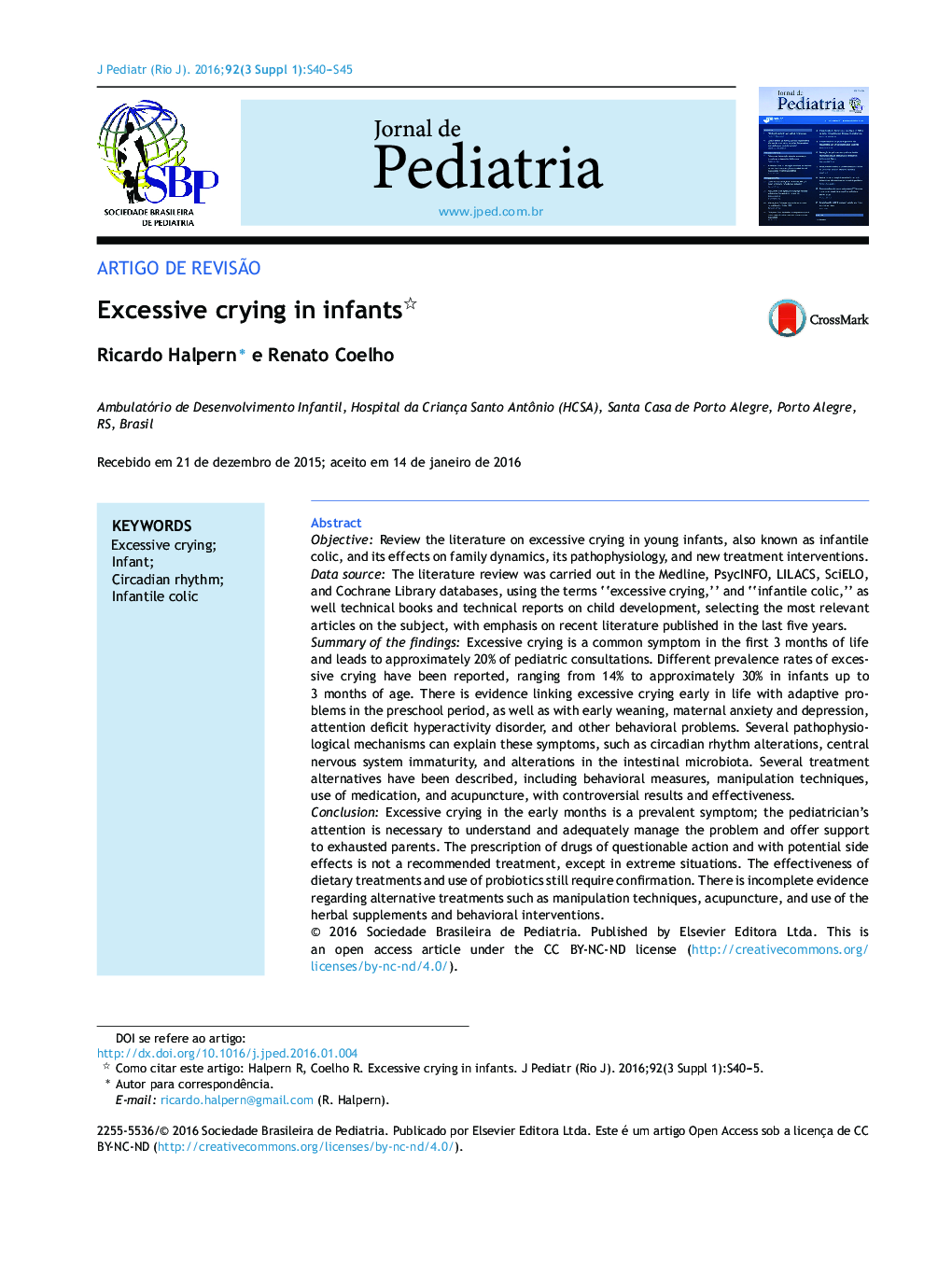| کد مقاله | کد نشریه | سال انتشار | مقاله انگلیسی | نسخه تمام متن |
|---|---|---|---|---|
| 4154289 | 1273702 | 2016 | 6 صفحه PDF | دانلود رایگان |
ObjectiveReview the literature on excessive crying in young infants, also known as infantile colic, and its effects on family dynamics, its pathophysiology, and new treatment interventions.Data sourceThe literature review was carried out in the Medline, PsycINFO, LILACS, SciELO, and Cochrane Library databases, using the terms “excessive crying,” and “infantile colic,” as well technical books and technical reports on child development, selecting the most relevant articles on the subject, with emphasis on recent literature published in the last five years.Summary of the findingsExcessive crying is a common symptom in the first 3 months of life and leads to approximately 20% of pediatric consultations. Different prevalence rates of excessive crying have been reported, ranging from 14% to approximately 30% in infants up to 3 months of age. There is evidence linking excessive crying early in life with adaptive problems in the preschool period, as well as with early weaning, maternal anxiety and depression, attention deficit hyperactivity disorder, and other behavioral problems. Several pathophysiological mechanisms can explain these symptoms, such as circadian rhythm alterations, central nervous system immaturity, and alterations in the intestinal microbiota. Several treatment alternatives have been described, including behavioral measures, manipulation techniques, use of medication, and acupuncture, with controversial results and effectiveness.ConclusionExcessive crying in the early months is a prevalent symptom; the pediatrician's attention is necessary to understand and adequately manage the problem and offer support to exhausted parents. The prescription of drugs of questionable action and with potential side effects is not a recommended treatment, except in extreme situations. The effectiveness of dietary treatments and use of probiotics still require confirmation. There is incomplete evidence regarding alternative treatments such as manipulation techniques, acupuncture, and use of the herbal supplements and behavioral interventions.
ResumoObjetivoRevisar a literatura sobre choro excessivo em bebês pequenos e cólicas infantis e suas repercussões na família e a fisiopatologia e as estratégias de tratamento.Fonte dos dadosRevisadas as principais bases de dados, Medline, PsycINFO, Lilacs e SciELO e Cochrane Library com o uso das expressões “choro excessivo do lactente” e “cólicas do lactente”. Foram selecionadas as publicações mais relevantes com ênfase nos últimos cinco anos.Síntese dos dadosÉ um sintoma comum nos primeiros meses de vida e é motivo de cerca de 20% das consultas pediátricas. As prevalências de choro excessivo variam de 14 a 30% nesses lactentes. Existem evidências que ligam o choro excessivo nos primeiros meses de vida com problemas futuros, bem como ao desmame precoce, à ansiedade, à depressão materna, ao transtorno do déficit de atenção/hiperatividade (TDAH) e a outros problemas comportamentais. Distintos mecanismos fisiopatológicos podem explicar esse quadro clínico, como alterações no ritmo circadiano, imaturidade do SNC e alterações na microbiota intestinal. São descritas opções de tratamento, desde medidas comportamentais, técnicas manipulativas e uso de medicação até acupuntura, com resultados e eficácia controversos.ConclusãoPara o choro excessivo nos primeiros meses é necessária a atenção do pediatra para o entendimento e manejo do problema e oferecer apoio para pais em exaustão. A prescrição de drogas de efeitos duvidosos e potenciais efeitos colaterais não é terapêutica preconizada, a não ser em situações extremas. A eficácia dos tratamentos dietéticos e o uso de probióticos ainda necessitam de confirmação. Existem evidências incompletas a respeito de tratamentos opcionais, como técnicas manipulativas, acupuntura, uso de suplemento à base de ervas e intervenções comportamentais.
Journal: Jornal de Pediatria (Versão em Português) - Volume 92, Issue 3, Supplement 1, May–June 2016, Pages S40–S45
